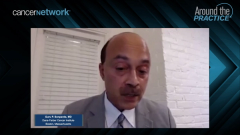
JAVELIN Bladder 100 Study in Advanced Urothelial Cancer
Thomas Powles, MBBS, MRCP, MD, reviews data and results from the phase 3 JAVELIN Bladder 100 trial for patients with locally advanced or metastatic urothelial cancer.
Episodes in this series

Petros Grivas, MD, PhD: Tom, would you like to guide us through the JAVELIN trial design, patient population, main end points, and key results?
Thomas Powles, MBBS, MRCP, MD: The JAVELIN trial enrolled 700 patients. It was a 1:1 randomization that compared avelumab plus best supportive care vs best supportive care alone, and the end points were overall survival in the ITT [intention-to-treat] population and the biomarker-positive population. The inclusion criteria were patients with advanced urothelial cancer and patients who had had 4 to 6 cycles of platinum-based chemotherapy, gemcitabine-cisplatin or gemcitabine-carboplatin. Patients who had progressed on chemotherapy were excluded, and a CT scan was required before randomization.
Patients were randomized between 4 and 10 weeks after the completion of chemotherapy. Patients had a performance status of 0 or 1. They were in relatively good shape postchemotherapy, but that’s often the case. Obviously, other exclusion criteria included contraindications for immunotherapy. Concerning the results of the trial, the primary end points showed a hazard ratio of 0.69, which is a 31% reduction in the risk of death, 21 vs 14 months median overall survival. It was also positive with a hazard ratio of 0.56 in the PD-L1–positive population that was a coprimary end point. The hazard ratio for PFS [progression-free survival] was also statistically significant with a tail on the curve of about 30% at 24 months, suggesting a subgroup of patients has durable remission with immune checkpoint inhibitors with avelumab, which wasn’t the case in the control arm. The adverse-event profile was in line with what you’d expect with an immune checkpoint inhibitor, with about 10% of patients discontinuing for adverse events and 10% of patients requiring high-dose steroid intervention.
Concerning the other key end points, the forest plot analysis showed benefit irrespective of the type of chemotherapy, the PD-L1 status, and the response to therapy. There were also quality-of-life data, which didn’t show a significant detrimental effect of the immune checkpoint inhibitor compared with the control arm. In summary, it’s the first trial that showed a survival signal in the frontline setting with an immune checkpoint inhibitor. Indeed, it’s the lowest survival signal in any trial in urothelial cancer that we’ve seen. If we go back in time and look at all the studies we’ve done, is this where we wanted to end up? The answer would be no. We would have wanted to have 30% CR [complete response] rates with immune checkpoint inhibitors and chemotherapy. We’d have wanted to see durvalumab and tremelimumab curing PD-L1+ patients. Many people in the community were surprised that there hasn’t been the same interaction between chemotherapy and immunotherapy as we’ve seen in lung cancer, for example. Nevertheless, this sequencing effect is actually quite patient-friendly, No. 1. And No. 2, it’s the only plan we have that has achieved this survival signal, which is important. That’s why most people we speak to, including the audience here today, feel this is the standard approach.
Petros Grivas, MD, PhD: Thank you, Tom. That’s a fantastic summary of the JAVELIN Bladder 100 trial. Based on what you just discussed, this resulted in the FDA approval of avelumab as switch maintenance therapy. If I count correctly, this was the end of June 2020 after your oralpresentation at the planned session at ASCO [American Society of Clinical Oncology Annual Meeting] 2020. But the FDA approval, and subsequently the NCCN [National Conference Cancer Network] Guidelines and the ESMO [European Society for Medical Oncology] Clinical Practice Guidelines changed in early July 2020.
As you pointed out, Tom, we have level 1 evidence based on this phase 3 trial, the first and only phase 3 trial that showed overall survival benefit with immune checkpoint inhibitor in the frontline setting in the switch maintenance setting. This has significant uptake in the clinical practice. Guru, maybe in a couple of minutes, can you comment on another maintenance trial by Dr [Matthew] Galsky in the Hoosier [Cancer Research Network] oncology group with pembrolizumab? Any quick comments on that?
Guru P. Sonpavde, MD: Sure, Petros. This was a randomized phase 2 trial, so it was a much smaller trial, looking at switch-maintenance pembrolizumab vs placebo, and there was a crossover built into the design. PFS was a primary end point. The trial was positive for progression-free survival improvement. There wasn’t an overall survival improvement, but that was a secondary end point, and the trial isn’t powered for survival. This study goes in the same direction as, of course, the much larger JAVELIN trial. One of the interesting findings is that in the pembrolizumab trial, there was an extension of PFS, which is going in the right direction. We all think those are supportive data, although as you know, pembrolizumab is not officially FDA approved for switch maintenance at this time.
Petros Grivas, MD, PhD: Thank you, Guru. That was a great summary. Thus, there was PFS benefit with switch-maintenance pembrolizumab in the Hoosier Cancer Research Network trial, but there were no survival benefits. The level 1 evidence remains with JAVELIN Bladder 100 and the available mechanism as Tom pointed out.
Transcript edited for clarity.
Newsletter
Stay up to date on recent advances in the multidisciplinary approach to cancer.

























































































